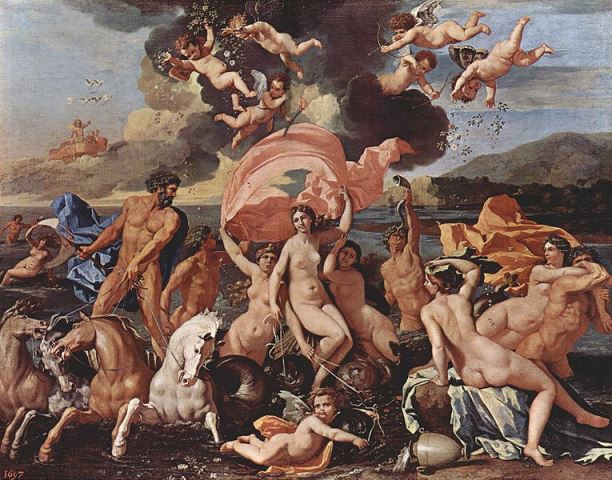Greek God Poseidon
Greek god Poseidon (god Neptune, in Roman mythology) is best known as the God of Sea, but he was also the god of earthquakes and horses.
He was the son of Cronus and Rhea. Just like his brothers and sisters (Hestia, Demetra, Hera, Hades, and Zeus), he was swallowed by his father right after he was born, but later he was brought up again (there is also another version, according to which Rhea told Cronus she had given birth to a horse and presented him a foal to swallow. God Poseidon grew up in a flock of lambs).
Together with his brothers, he took part in the Titanomachy. After Cronus was defeated, Poseidon drew lots with Zeus and Hades, and got the kingdom of the Sea.
He was usually represented as carrying a trident and accompanied by dolphins. His carriage was a huge shell, drawn by horses or sea-horses (the metaphor waves = horses is very clear).
This is quite a good representation of how he was conceived:
Neptune's Horses,...
Walter Crane
Buy This at Allposters.com
The Greek god Poseidon had an ever-changing temperament. When he was in a good mood, he would create new islands (just like he did for Clito, one of his lovers, thus creating the island of Atlantis). More often, though, he was in a bad mood and he would shake his trident, thus producing earthquakes, seismic waves or causing volcanoes to erupt.
Greek god Poseidon had a quarrel with goddess Athena when they fought for the city of Athens. They had to produce a useful gift for the people of the city: Poseidon hit the ground and made a spring of salt water, while Athena made the olive tree. Infuriated by the fact that his gift was considered useless, Poseidon flooded the city. Later, trying to make up for this, he « invented » the horse.
His wife was the nereid Amphitrite, one of god Oceanus’ granddaughters. The Greek god Poseidon had seen her while she was playing with her sisters, and he fell in love in her.

The Triumph of Neptune and Amphitrite
by Nicolas Poussin
Although he had a beautiful wife, he would always chase some other goddess/woman, and when they wouldn’t give in to him, he would get what he wanted by the force. He even wooed the awful Medusa (that’s something I’ll never understand).
Once he fell in love with his own sister, Demeter, who tried to flee from him. She transformed into a mare, in order to get rid of him, but Poseidon transformed into a horse and thus they had a son, Arion, the talking horse.
Together with Apollo, the Greek god Poseidon built the walls of the city of Troy, but king Laomedon refused to pay them. That’s why Poseidon was against the Trojans during the war.
He punished the greek hero Odysseus, who had wounded his son, the cyclops Polyphemus, and made him wander for ten long years on the seas… making thus possible the writing of the Odyssey :-)
Children :
- with his wife, Amphitrite: a son, Triton (a kind of a he-mermaid), and a daughter, Rhode
- with Gaea (wait a minute, wasn’t she his grandma?): Antaeus
- with Medusa: Chrysaor
- with Thoosa: Polyphemus
- with Aethra: Theseus (finally, a human!)
- with Chione : Eumolpus
- with Clito: 10 sons, one of which was called Atlas – it was this son who gave the name to the island of Atlantis
Pictures of Greek god Poseidon:
|

Poseidon
Fuger, Heinrich
Buy this Art Print at AllPosters.com

Sea King's Chariot
John Eliot
Buy From Art.com
These are the ruins of the 4th century BC Temple of Poseidon, on the Apollo Coast., Athens, Attica, Greece
|
For more pictures of greek god Poseidon (called Neptune in art), click here.
Not exactly what you were looking for? Keep on searching!

Custom Search







